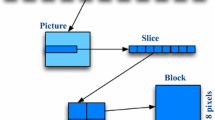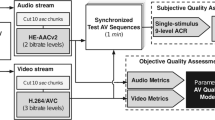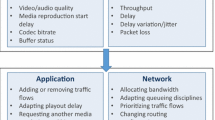Abstract
While previous expensive and complex desktop video conferencing solutions had a restricted reach, the emergence of the WebRTC (Web Real-Time Communication) open framework has provided an opportunity to redefine the video conferencing communication landscape. In particular, technological advances in terms of high resolution displays, cameras, and high speed wireless access networks have set the ground for emerging multiparty video telemeeting solutions realized via mobile devices. However, deploying multiparty video communication solutions on smart phones calls for the need to optimize video encoding parameters due to limited device processing power and dynamic wireless network conditions. In this paper, we report on a subjective user study involving 30 participants taking part in three-party audiovisual telemeetings on mobile devices. We conduct an experimental investigation of the Google Congestion Control (GCC) Algorithm in light of packet loss and under various video codec configurations, with the aim being to observe the impact on end user Quality of Experience (QoE). Results provide insights related to QoE-driven video encoding adaptation (in terms of bit rate, resolution, and frame rate), and show that in certain cases, adaptation invoked by GCC leads to video interruption. In majority of other cases, we observed that it took approximately 25 s for the video stream to recover to an acceptable quality level after the temporary occurrence of network packet loss.
Access this chapter
Tax calculation will be finalised at checkout
Purchases are for personal use only
Similar content being viewed by others
References
Skowronek, J.: Quality of experience of multiparty conferencing and telemeeting systems. Ph.D. thesis, Technical University of Berlin (2017)
Vučić, D., Skorin-Kapov, L., Sužnjević, M.: The impact of bandwidth limitations and video resolution size on QoE for WebRTC-based mobile multi-party video conferencing. In: Proceedings of the 5th ISCA/DEGA Workshop on Perceptual Quality of Systems, PQS, Berlin (2016)
Carlucci, G., et al.: Congestion control for web real-time communication. IEEE/ACM Trans. Networking (TON) 25(5), 2629–2642 (2017)
Holmer, S., Lundin, H., Carlucci, G., De Cicco, L., Mascolo, S.: A google congestion control algorithm for real-time communication, IETF draft (2016)
Alvestrand, H.: Overview: real time protocols for browser-based applications (2013)
Carlucci, G., De Cicco, L., Holmer, S., Mascolo, S.: Analysis and design of the google congestion control for web real-time communication (WebRTC). In: Proceedings of the 7th International Conference on Multimedia Systems, p. 13. ACM (2016)
ITU-T. Recommendation P.1301: Subjective quality evaluation of audio and audiovisual telemeetings. International Standard. International Telecommunication Union, Geneva, Switzerland (2017)
Schmitt, M., Redi, J., Cesar, P., Bulterman, D.: 1Mbps is enough: video quality and individual idiosyncrasies in multiparty HD video-conferencing. In: Eighth International Conference on Quality of Multimedia Experience (QoMEX), pp. 1–6. IEEE (2016)
Schmitt, M., Redi, J., Cesar, P.: Towards context-aware interactive Quality of Experience evaluation for audiovisual multiparty conferencing. In: Proceedings of the 5th PQS, Berlin, pp. 64–68 (2016)
Schmitt, M., Redi, J., Bulterman, D., Cesar, P.S.: Towards individual QoE for multiparty videoconferencing. IEEE Trans. Multimedia 20(7), 1781–1795 (2018)
Jansen, B., Goodwin, T., Gupta, V., Kuipers, F., Zussman, G.: Performance evaluation of WebRTC-based video conferencing. ACM SIGMETRICS Perform. Eval. Rev. 45(2), 56–68 (2018)
Yu, C., Xu, Y., Liu, B., Liu, Y.: “Can you SEE me now?” A measurement study of mobile video calls. In: 2014 Proceedings of IEEE, INFOCOM, pp. 1456–1464 (2014)
Schmitt, M., Gunkel, S., Cesar, P., Bulterman, D.: The influence of interactivity patterns on the Quality of Experience in multi-party video-mediated conversations under symmetric delay conditions. In: Proceedings of the 3rd International Workshop on Socially-aware Multimedia, pp. 13–16 (2014)
Xu, J., Wah, B.W.: Exploiting just-noticeable difference of delays for improving quality of experience in video conferencing. In: Proceedings of the 4th ACM Multimedia Systems Conference, pp. 238–248. ACM (2013)
Fouladi, S., Emmons, J., Orbay, E., Wu, C., Wahby, R.S., Winstein, K.: Salsify: low-latency network video through tighter integration between a video codec and a transport protocol. In: 15th (USENIX) Symposium on Networked Systems Design and Implementation (2018)
Ammar, D., De Moor, K., Xie, M., Fiedler, M., Heegaard, P.: Video QoE killer and performance statistics in WebRTC-based video communication. In: Sixth International Conference on Communications and Electronics (ICCE), pp. 429–436. IEEE (2016)
De Moor, K., Arndt, S., Ammar, D., Voigt-Antons, J.N., Perkis, A., Heegaard, P.E.: Exploring diverse measures for evaluating QoE in the context of WebRTC. In: 2017 Ninth International Conference on Quality of Multimedia Experience (QoMEX), pp. 1–3. IEEE (2017)
Author information
Authors and Affiliations
Corresponding author
Editor information
Editors and Affiliations
Rights and permissions
Copyright information
© 2019 Springer Nature Switzerland AG
About this paper
Cite this paper
Vucic, D., Skorin-Kapov, L. (2019). The Impact of Packet Loss and Google Congestion Control on QoE for WebRTC-Based Mobile Multiparty Audiovisual Telemeetings. In: Kompatsiaris, I., Huet, B., Mezaris, V., Gurrin, C., Cheng, WH., Vrochidis, S. (eds) MultiMedia Modeling. MMM 2019. Lecture Notes in Computer Science(), vol 11295. Springer, Cham. https://doi.org/10.1007/978-3-030-05710-7_38
Download citation
DOI: https://doi.org/10.1007/978-3-030-05710-7_38
Published:
Publisher Name: Springer, Cham
Print ISBN: 978-3-030-05709-1
Online ISBN: 978-3-030-05710-7
eBook Packages: Computer ScienceComputer Science (R0)




